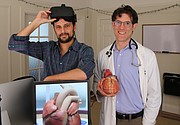8/4/2017

By AMERICAN HEART ASSOCIATION NEWS
Virtual reality has been a staple of science fiction ever since Stanley G. Weinbaum wrote about high-tech goggles in 1935’s Pygmalion’s Spectacles. Now that virtual reality has become actual reality, it’s slowly but surely revolutionizing the treatment of heart disease and stroke.
“In the next couple of years, every medical center will have virtual reality in some respect. I think it will be as ubiquitous as the smartphone,” said David M. Axelrod, M.D., clinical assistant professor of pediatric cardiology at Stanford University School of Medicine.
“The heart and the brain are two of the most complex organs to understand in a three-dimensional way, and virtual reality is going to change the way students and patients learn about heart disease and stroke,” he said.
The change is already happening.
Axelrod and other pediatric cardiologists at Stanford are using a VR tool called the Stanford Virtual Heart to help explain complicated heart problems to students and families of children undergoing surgery. Users strap on a VR headset, grab a remote control and teleport inside the heart’s chambers and vessels, said Axelrod, who is also the lead medical advisor and a shareholder at Lighthaus, Inc., which created the Stanford Virtual Heart.
At the University of Minnesota Medical School’s Visible Heart Laboratory, doctors working within virtual reality are able to put tiny leadless pacemakers inside various 3-D models of the heart.
“Physicians can drive through the anatomy, blow it up, shrink it, and explain a defect to someone,” said Paul Iaizzo, Ph.D., professor of surgery and head of the Visible Heart Lab. “The surgeons we’ve talked to say, ‘For the first time, we have an easy tool to better explain to families what we need to do surgically.’”
Investing in virtual reality is a savvy way to inspire the next generation of medical students who grew up with their hands glued to video games, Iaizzo said.
“Now, instead of going home and playing games, they stay at the lab all night and create educational tools,” Iaizzo said. “It’s just as exciting for them, and even more rewarding, since they know they’re helping others.”
Virtual reality may also help improve emergency cardiovascular care – especially outside the classroom, where it’s most important.
Researchers at the University of Pennsylvania are studying whether VR can better prepare bystanders to perform CPR in a hectic urban setting. Unwitting participants are given virtual reality headsets and hand devices and suddenly have to deal with a cardiac arrest victim amid a backdrop of wailing sirens and hysterical bystanders.
“Virtual reality can really heighten the stress and realism of these events to help us understand how lay providers respond in real life,” said Marion Leary, R.N., director of innovation research for the Center for Resuscitation Science at the University of Pennsylvania.
“Do they call 911? Do they ask for an AED? Do they perform CPR? We’re hoping to not just train people with skills, but to emotionally and mentally prepare them to step up and respond when a real cardiac arrest occurs,” said Leary, who is also founder of ImmERge Labs, a startup company based on her VR research in emergency preparedness.
Virtual reality emerged in the 1990s in the world of video games, and has been slowly creeping into medicine ever since. In 2010, for example, surgeons began using the virtual reality Robotic Surgical Simulator, or RoSS, to learn how to operate the robotic da Vinci Surgical System.
Today, hundreds of researchers are exploring how VR can help treat everything from agoraphobia to burn wounds to stroke. Research suggests using a virtual reality interface can help improve movement and coordination of the arms, hands and fingers in stroke survivors.
According to a recent report by market research company Grand View Research, Inc., virtual and augmented reality in the healthcare market will pass $5 billion by 2025. But for now, the medical field is still in the early stages of using virtual reality to improve care for heart disease and stroke, Axelrod said.
Alyssa Giacalone, a physician assistant at Lucile Packard Children's Hospital Stanford, uses the Stanford Virtual Heart. (Photo courtesy of David Sarno)
“There’s so much opportunity and excitement, but the technology is so far ahead of where the market is, or even where the medical industry is at this time,” Axelrod said.
“But I’m optimistic there’s going to be a big leap forward. Pretty soon, we’ll be able to use virtual reality programs to teach everyone in the world. It won’t matter if they’re in New York City or a country village in China – anyone with a cellphone and the internet will immediately be able to learn about congenital heart disease,” he said.

